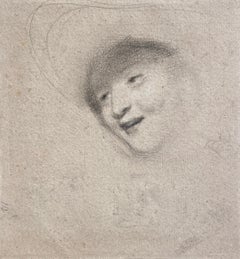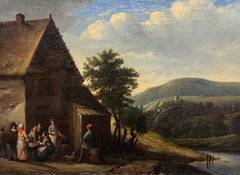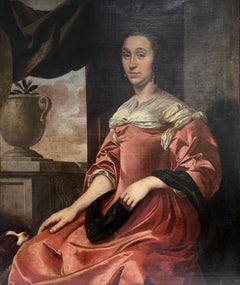Henry Perronet Briggs Art
to
1
1
2
2
1
Juliet and her Nurse..., Oil Painting on Canvas by Henry Perronet Briggs
By Henry Perronet Briggs
Located in Long Island City, NY
Artist: Henry Perronet Briggs, Attributed to, English (1793 - 1844)
Title: Juliet and Her Nurse with the Page Peter from Shakespeare's Romeo and Juliet
Year: circa 1820
Medium: Oil o...
Category
1820s Old Masters Henry Perronet Briggs Art
Materials
Canvas, Oil
Graphite Study of a Head, Monogrammed Victorian Sketch, Gilt Fame
By Henry Perronet Briggs
Located in London, GB
Graphite on paper, monogrammed lower left
Image size: 6 x 6 1/2 inches (15.25 x 16.5 cm)
Contemporary style handmade gilt frame
Henry Perronet Briggs
Henry Perronet Briggs RA wa...
Category
Early 19th Century Henry Perronet Briggs Art
Materials
Paper, Graphite
Related Items
Figures Chatting outside Village Tavern in Mountain Landscape, Period Oil
By 19th century Dutch or Flemish school
Located in Cirencester, Gloucestershire
Dutch/ Flemish School, early 1800's
oil on canvas, framed
framed: 19 x 24 inches
canvas: 13.5 x 18.5 inches
provenance: private collection, France
condition: good and sound condition...
Category
Early 19th Century Old Masters Henry Perronet Briggs Art
Materials
Oil, Canvas
$1,224 Sale Price
30% Off
H 19 in W 24 in
Huge 17th Century Dutch Old Master Oil Painting Portrait of Noble Lady & Dog
By Abraham van den Tempel
Located in Cirencester, Gloucestershire
Portrait of a Noble Lady with her dog
attributed to Abraham Lambertsz. van den Tempel, Dutch 1622 - 1672 *see notes below
oil on canvas, unframed
canvas: 40 x 33.5 inches
provenance...
Category
17th Century Old Masters Henry Perronet Briggs Art
Materials
Oil, Canvas
$13,094 Sale Price
30% Off
H 40 in W 33.5 in
J. Clays (British painter) - 19th century Still Life painting - Fruits
Located in Varmo, IT
J. Clays (British, 19th-20th century) - Still life with fruit basket.
61 x 51 cm without frame, 67.5 x 58 cm with frame.
Antique oil painting on canvas, in a gilded wooden frame.
...
Category
Late 19th Century Old Masters Henry Perronet Briggs Art
Materials
Canvas, Oil
$591 Sale Price
50% Off
H 26.58 in W 22.84 in
Fine Italian Old Master Oil Painting c. 1700's The Madonna Christ Child St. John
Located in Cirencester, Gloucestershire
The Madonna, Christ Child and St. John
Italian Old Master, circa 1700's period
oil painting on canvas, unframed
Canvas: 28.5 x 24 inches
conditon: overall very good for its age, a fe...
Category
Early 18th Century Old Masters Henry Perronet Briggs Art
Materials
Canvas, Oil
$3,734 Sale Price
30% Off
H 28.5 in W 24 in
Judith with the Head of Holofernes, Antique Oil Painting after Cristofano Allori
By Alessandro di Cristofano Allori
Located in Berlin, DE
Judith with the head of Holofernes, antique oil painting after Cristofano Allori.
Painting has been restored.
Dimensions without f...
Category
18th Century Old Masters Henry Perronet Briggs Art
Materials
Canvas, Oil
$6,623 Sale Price
20% Off
H 35.44 in W 27.56 in
Portrait of Lady Caroline Price
By George Romney
Located in Miami, FL
DESCRIPTION: Perhaps the best Romney in private hands. If Vogue Magazine existed in the late 18th century, this image of Lady Caroline Price would be ...
Category
1970s Old Masters Henry Perronet Briggs Art
Materials
Oil, Canvas
Fine 18th Century British Oil Painting Mother & Infant Child in Adoration
Located in Cirencester, Gloucestershire
Mother & Child
British artist, late 18th century
after the painting by Sir Anthony van Dyke
oil on canvas, unframed
canvas : 20 x 18 inches
provenance: private collection, Berkshire,...
Category
18th Century Old Masters Henry Perronet Briggs Art
Materials
Oil, Canvas
$2,354 Sale Price
30% Off
H 20 in W 18 in
Jean-Marc Nattier (1685 - 1766) - Portrait of Charlotte de Hesse-Rheinfels
By Jean-Marc Nattier
Located in PARIS, FR
Jean-Marc Nattier (Paris, 1685 - 1766) and his workshop
Portrait of Charlotte de Hesse-Rheinfels
Oil on canvas : h. 44.09 in, w. 38.19 in
18th century carved giltwood framed
Fra...
Category
1730s Old Masters Henry Perronet Briggs Art
Materials
Canvas, Oil
$65,056
H 52.36 in W 47.63 in
COUNTRY SCENE- Italian School - Figurative Italian Oil on Canvas Painting
By Giovanni Santaniello
Located in Napoli, IT
Country scene - Oil on canvas cm.80x120, Giovanni Santaniello, Italy 2002
Gold gilded wooden frame available on request
The painting by Giovanni Santaniello depicts a scene of return...
Category
Early 2000s Old Masters Henry Perronet Briggs Art
Materials
Canvas, Oil
$5,299
H 38.19 in W 53.94 in D 1.58 in
CHERUBIM PLAYING - Italian School - Figurative Oil on Canvas Painting
By Giulio Di Sotto
Located in Napoli, IT
Cherubim playing - Giulio Di Sotto Italia 2004 - Oil on canvas cm. 50 x 100
Gold dilded wooden frame available on request.
The proposed painting represents two putti playing ..
Cle...
Category
Early 2000s Old Masters Henry Perronet Briggs Art
Materials
Canvas, Oil
$3,785
H 19.69 in W 39.38 in
18th century allegorical painting of The Triumph of Beauty
Located in London, GB
Exhibited:
London, Royal Academy, 1800, no. 93
What was happening in British history painting in around 1800? In recent discussions of the emergence of a British School of history painting following the foundation of the Royal Academy in 1768, this is a question which is rarely posed and one which is not easily answered. Examination of surviving Royal Academy exhibition catalogues reveals a profusion of artists’ names and titles, few of which remain immediately recognizable, whilst endeavours to explain the impact of exhibition culture on painting - such as the 2001 Courtauld show Art on the Line - have tended to focus on the first and second generation of Royal Academician, rather than young or aspiring artists in the early nineteenth century. This makes the discovery and identification of the work under discussion of exceptional importance in making sense of currents in English painting around 1800. Executed by Edward Dayes...
Category
18th Century Old Masters Henry Perronet Briggs Art
Materials
Canvas, Oil
$243,120
H 50 in W 36 in
Answer Within
Located in Ibadan, Oyo
Painting
Ships in a well-protected tube from Nigeria
This work is unique, this is not a print or other type of copy.
Accompanied by a Certificate of Authenticity (Issued by the Gallery)
Category
21st Century and Contemporary Old Masters Henry Perronet Briggs Art
Materials
Canvas, Oil
Henry Perronet Briggs art for sale on 1stDibs.
Find a wide variety of authentic Henry Perronet Briggs art available for sale on 1stDibs. You can also browse by medium to find art by Henry Perronet Briggs in canvas, fabric, graphite and more. Much of the original work by this artist or collective was created during the 19th century and is mostly associated with the Old Masters style. Not every interior allows for large Henry Perronet Briggs art, so small editions measuring 2 inches across are available. Customers who are interested in this artist might also find the work of Michela De Vito, George Romney, and William Bromley. Henry Perronet Briggs art prices can differ depending upon medium, time period and other attributes. On 1stDibs, the price for these items starts at $1,934 and tops out at $5,000, while the average work can sell for $3,467.


